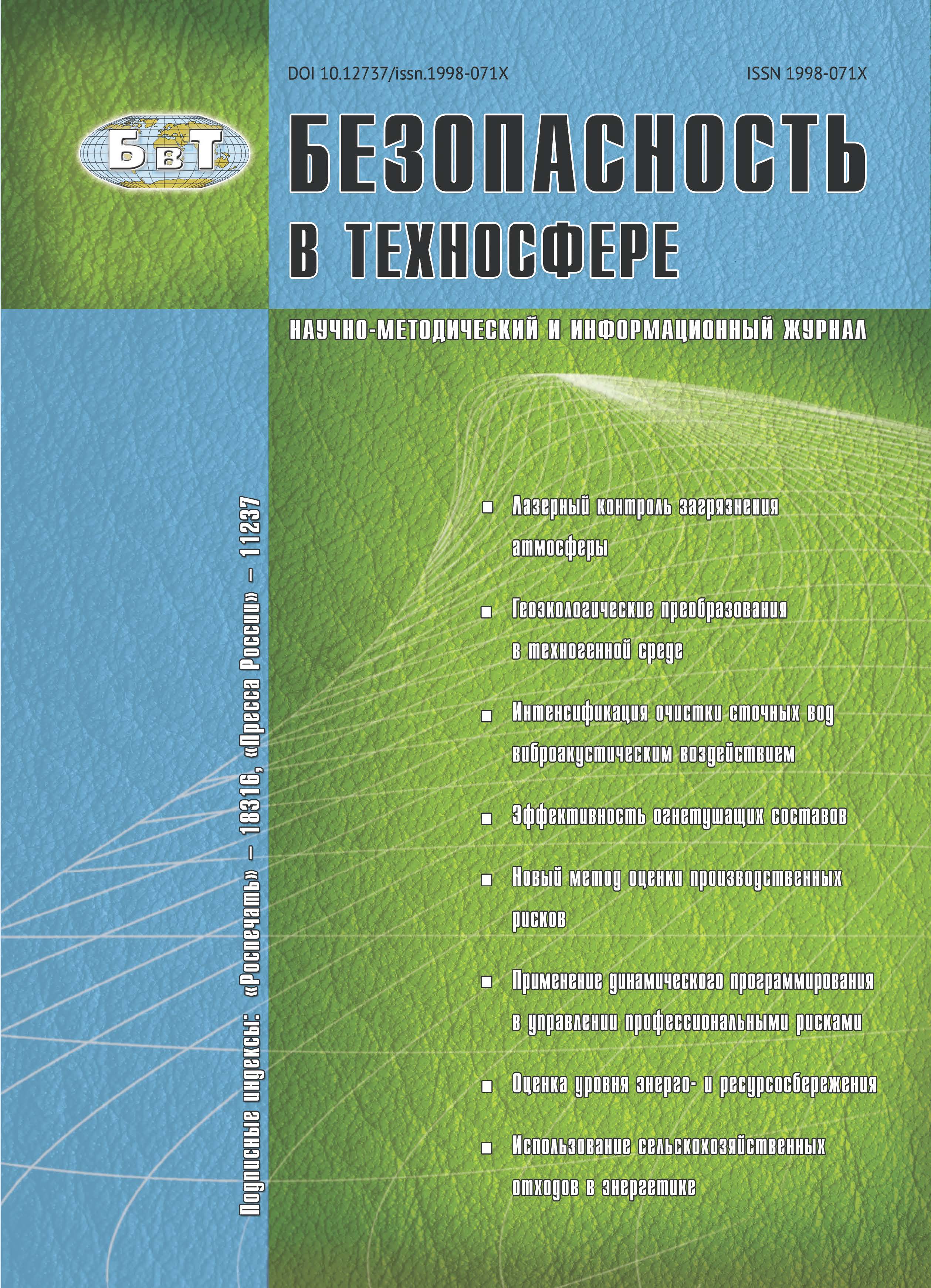Russian Federation
Russian Federation
As a result of many years of economic activity, a large number of anthropogenic factors arise that change the dynamics of the transformation of the quality of surface waters. The growing deterioration in their quality is due to the long-term impact of various pollution sources (industrial production, road transport, agriculture, technogenic deposits, heat power facilities, oil and gas pipelines, etc.). However, a wide range of heavy metals enters the surface waters, along with the increase in macrocomponents during technogenic dispersion of toxicants. This requires a systemic evaluation of surface water. Modern methods are based on the use of devices that have been used up, recyclable or disposable paper sets with a perceptible range of error in the determination. In this paper, for the rapid analysis of the state of surface waters on the presence of heavy metals, solid-state polymer indicators were used. The possibility of non-laboratory application in practice of color solid-state polymeric indicators of reusable use, preserving shades of color for two years or more, is shown. Characteristics of indicators were studied in laboratory conditions and tested in the study of lake and river water in several Russian regions (Lake Valday, Polomet River, Onego Lake, etc.). The developed methodology is based on the testimony of four parameters: temperature, pH; The changed color of the polymer indicator, followed by a comparison of pH and color with the indicator’s reference scale; Of the total index of water pollution by heavy metals. Comparing the results with the indicators of the working scale, in which all four indicators are included, the estimation of the level of contamination by heavy metals of surface waters with high accuracy is carried out. In addition, this method makes it possible to establish the significant role of bottom sediments in the formation of surface water quality. The results of the carried out research make it possible to increase the number of observations in time and space and to obtain a significant amount of information base on the ecological state of water bodies during their monitoring.
color plastic indicators, heavymetals, surface water, monitoring.
1. Введение
Поверхностные воды относятся к важным компонентам природной среды и содержат значительные запасы пресной воды (водохранилища, озерные системы, реки). В условиях интенсивной хозяйственной деятельности их загрязнение стало одной из актуальных экологических проблем [1–4].
1. Zlobina V. L. Ekologicheskie posledstviya antropogennogo vozdeystviya na podzemnye vody [Ecological consequences of anthropogenic impact on groundwater]. Materialy XIII Vserossiyskoy nauchno-prakticheskoy konferentsii s mezhdunarodnym uchastiem [Proceedings of the 13th All-Russian Scientific and Practical Conference with International Participation]. 2015, pp. 51-55. (in Russian)
2. Moissenko T. I. Zakislenie vod, faktory, mekhanizmy i ekologicheskie posledstviya [Water oxidation, factors, mechanisms and ecological consequences]. Moscow, Nauka Publ., 2003. 276 p. (in Russian)
3. Moissenko T. I., Gashkina N. A. Formirovanie khimicheskogo sostava ozer v usloviyakh izmeneniya okruzhayushchey sredy [Formation of the chemical composition of lakes in conditions of environmental change]. Moscow, Nauka Publ. 2010. 267 p. (in Russian)
4. Nedogarko I. V. Formirovanie vneshney biogennoy nagruzki na ozernye ekosistemy v usloviyakh severo-zapadnoy ozerno-morennoy oblasti. Kand. Diss [Formation of an external biogenic load on lake ecosystems in the conditions of the northwestern lacustrine-moraine region. Cand. Diss]. Valday, 2000. 26 p. (in Russian)
5. Putyrskiy V. E., Zlobina V. L. Tekhnogennaya transformatsiya ozernykh sistem Valdayskogo regiona [Technogenic transformation of the lake systems of the Valdai region]. Vodnoe khozyaystvo Rossii [Water management in Russia]. 2010, I. 5, pp. 70-80. (in Russian)
6. Reshetnyak E. A., Nikitina N. A. Vliyanie materiala nositelya na predel obnaruzheniya pri vizual’nom testirovanii [Inf luence of the carrier material on the detection limit during visual testing]. Vestnik Khar’kovskogo natsional’nogo universiteta. Khimiya [Bulletin of the Kharkov National University. Chemistry]. 2007, V. 15 (38), I. 770, pp. 119-125. (in Russian)
7. Leykin Yu.A., Cherkasova T. A., Kumpanenko I. V., Elinek A. V. Tverdofaznye tsvetnye indikatory i razrabotka metodologii tsifrovoy obrabotki tsveta dlya sozdaniya shkal vysokoy tochnosti [Solid-phase color indicators and the development of a methodology for digital color processing to create high accuracy scales]. Khimicheskaya fizika [Chemical Physics]. 2007, V. 26, I. 10, pp. 60-67. (in Russian)
8. Leykin Yu.A. Fiziko-khimicheskie osnovy sinteza polimernykh sorbentov [Physico-chemical basis of synthesis of polymeric sorbents]. Moscow, BINOM. Laboratoriya znaniy Publ., 2011. 413 p. (in Russian)
9. Normativy kachestva vody vodnykh ob”ektov rybokhozyaystvennogo znacheniya, v tom chisle normativy predel’no-dopustimykh kontsentratsiy vrednykh veshchestv v vodnykh ob”ektakh rybo-khozyaystvennogo znacheniya ot 09.02.2010 g. Federal’noe agentstvo po rybolovstvu. Nomer registratsii № 16326 [Normative water quality of water objects of fish-economic importance, including standards for maximum permissible concentrations of harmful substances in water bodies of fish-economic importance of 09.02.2010. Federal Agency for Fisheries. Registration No. 16326].
10. Tarasova N. P., Cherkasova T. A., Kugotova M. M., Miziev M. A. Sopolimery stirola i divinilbenzola s khromogennymi gruppami dlya kontrolya okruzhayushchey sredy [Copolymers of styrene and divinylbenzene with chromogenic groups for environmental control]. Bezopasnost’ v tekhnosfere [Safety in the technosphere]. 2016, I. 2, pp. 3-10. (in Russian)
11. Reshetnyak E. A., Shevchenko V. N., Ostrovskaya V. M. Indikatornaya bumaga dlya opredeleniya summarnogo soderzhaniya tyazhelykh metallov v vodnykh sredakh [Indicator paper for determination of the total content of heavy metals in aqueous media]. Voda: khimiya i ekologiya [Water: chemistry and ecology]. 2015, I. 2, pp. 65-71. (in Russian)
12. Leykin Yu.A. Osnovy ekologicheskogo normirovaniya [Fundamentals of environmental rationing]. Moscow, FORUM: infra-m Publ., 2014. 368 p. (in Russian)
13. Kocharyan A. G., Tolkachev G. Yu. Formy sushchestvovaniya tyazhelykh metallov v donnykh otlozheniyakh Ivan’kovskogo vodokhranilishcha [Forms of existence of heavy metals in bottom sediments of the Ivankovo reservoir]. Melioratsiya i vodnoe khozyaystvo [Melioration and water management]. 2009, I. 1, pp. 20-24. (in Russian)
14. Skjelkvale B. L., Anderson T. Heavy metal surveys in Nordic lakes // Ambio. 2001. V. 39. N.1. p.2






